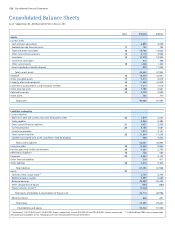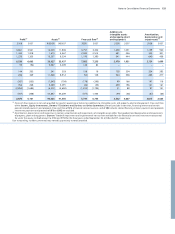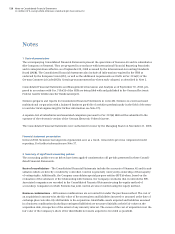Siemens 2008 Annual Report Download - page 225
Download and view the complete annual report
Please find page 225 of the 2008 Siemens annual report below. You can navigate through the pages in the report by either clicking on the pages listed below, or by using the keyword search tool below to find specific information within the annual report.
Notes to Consolidated Financial Statements 129
(in millions of €, except where otherwise stated and per share amounts)
Goodwill – Goodwill is not amortized, but instead tested for impairment annually, as well as whenever there
are events or changes in circumstances (“triggering events”) which suggest that the carrying amount may not
be recoverable. Goodwill is carried at cost less accumulated impairment losses.
The goodwill impairment test is performed at the level of cash-generating unit or groups of cash-generating
units which represent the lowest level at which goodwill is monitored for internal management purposes.
For the purpose of impairment testing, goodwill acquired in a business combination is allocated to the (groups)
of cash-generating unit(s) that are expected to benet from the synergies of the business combination. If the
carrying amount of the division, to which the goodwill is allocated, exceeds its recoverable amount goodwill
allocated to this division is reduced accordingly. The recoverable amount is the higher of the division’s fair value
less costs to sell and its value in use. Siemens generally determines the recoverable amount of a division based
on its fair value less costs to sell. These values are generally determined based on discounted cash ow calcula-
tions. Impairment losses on goodwill are not reversed in future periods if the recoverable amount exceeds the
carrying amount of the (group of) cash-generating unit(s) to which the goodwill is allocated (see Note 16 for
further information).
Other intangible assets – Other intangible assets consist of software and other internally generated intangible
assets, patents, licenses and similar rights. The Company amortizes intangible assets with nite useful lives on
a straight-line basis over their respective estimated useful lives to their estimated residual values. Estimated
useful lives for software, patents, licenses and other similar rights generally range from three to ve years,
except for intangible assets with nite useful lives acquired in business combinations. Intangible assets acquired
in business combinations primarily consist of customer relationships and technology. Weighted average useful
lives in specic acquisitions ranged from nine to twenty-two years for customer relationships and from seven to
twelve years for technology. Intangible assets which are determined to have indenite useful lives as well as
intangible assets not yet available for use are not amortized, but instead tested for impairment at least annually
(see Note 17 for further information).
Property, plant and equipment – Property, plant and equipment is valued at cost less accumulated depreciation
and impairment losses. If the costs of certain components of an item of property, plant and equipment are sig-
nicant in relation to the total cost of the item, they are accounted for and depreciated separately. Depreciation
expense is recognized using the straight-line method. Costs of construction of qualifying long-term assets
include capitalized interest, which is amortized over the estimated useful life of the related asset. The following
useful lives are assumed:
Impairment of property, plant and equipment and other intangible assets with nite useful lives – The
Company reviews property, plant and equipment and other intangible assets for impairment whenever events
or changes in circumstances indicate that the carrying amount of an asset may not be recoverable. Recoverability
of assets is measured by the comparison of the carrying amount of the asset to the recoverable amount, which
is the higher of the asset’s value in use and its fair value less costs to sell. If such assets are considered to be
impaired, the impairment to be recognized is measured by the amount by which the carrying amount of the
assets exceeds their recoverable amount. If the fair value cannot be determined, the assets’ value in use is
Factory and ofce buildings 20 to 50 years
Other buildings 5 to 10 years
Technical machinery & equipment 5 to 10 years
Furniture & ofce equipment generally 5 years
Equipment leased to others generally 3 to 5 years
























